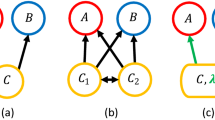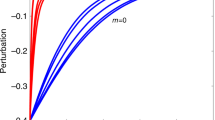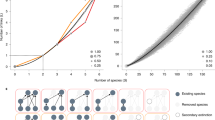Abstract
The loss or removal of individual species can cause dramatic changes in communities1,2,3,4,5. Experiments indicate that in many communities only a few species will have such strong effects, whereas most will have weak effects owing to small per capita effects and/or low abundance3,6,7,8,9,10,11,12,13,14,15,16. But extinction of these ‘weak’ interactors could significantly alter natural communities because they play important stabilizing or ‘noise-dampening’ roles14,15,17,18,19,20,21,22,23. I demonstrate here that some ‘weak’ interactors may also be important by magnifying spatiotemporal variation in community structure. An analysis of published interaction strength data shows that the greatest variation in species effect occurred for the weakest interactions. A field experiment corroborates this and shows how indirect interactions can generate an inverse relationship between the mean and variance of a consumer's impact on its prey. When a species' effects are highly variable in sign and magnitude, they may average to seem weak over broad scales but be strong in local contexts. Thus, what is frequently considered to be ‘noise’ in species interaction data may be a critical part of the signal.
This is a preview of subscription content, access via your institution
Access options
Subscribe to this journal
Receive 51 print issues and online access
$199.00 per year
only $3.90 per issue
Buy this article
- Purchase on Springer Link
- Instant access to full article PDF
Prices may be subject to local taxes which are calculated during checkout




Similar content being viewed by others
References
Paine, R. T. Anote on trophic complexity and community stability. Am. Nat. 103, 91–93 (1969).
Paine, R. T. Intertidal community structure. Experimental studies on the relationship between a dominant competitor and its principal predator. Oecologia 15, 93–120 (1974).
Power, M. E. et al. Challenges in the quest for keystones. BioScience 46, 609–620 (1996).
Menge, B. A., Berlow, E. L., Blanchette, C., Navarrete, S. A. & Yamada, S. B. The keystone species concept: variation in interaction strength in a rocky intertidal habitat. Ecol. Monogr. 64, 249–286 (1994).
Estes, J. A. & Palmisano, J. F. Sea otters: their role in structuring nearshore communities. Science 185, 1058–1060 (1974).
Paine, R. T. Food-web analysis through field measurement of per capita interaction strength. Nature 355, 73–75 (1992).
Fagan, W. F. & Hurd, L. E. Hatch density variation of a generalist arthropod predator: population consequences and community impact. Ecology 75, 2022–2032 (1994).
Raffaelli, D. G. & Hall, S. J. in Food Webs: Integration of Patterns and Dynamics(eds Polis, G. & Winemiller, K.) 185–191 (Chapman and Hall, New York, (1995).
Wootton, J. T. Estimates and tests of per-capita interaction strength: diet, abundance, and impact of intertidally-foraging birds. Ecol. Monogr. 67, 45–64 (1997).
Hooper, D. U. & Vitousek, P. M. The effects of plant composition and diversity on ecosystem processes. Science 277, 1302–1305 (1997).
Tilman, D. et al. The influence of functional diversity and composition on ecosystem processes. Science 277, 1300–1308 (1997).
Wardle, D. A., Zackrisson, O., Hörnbreg, G. & Gallet, C. The influence of island area on ecosystem properties. Science 277, 1296–1299 (1997).
Symstad, A. J., Tilman, D., Wilson, J. & Knops, J. M. H. Species loss and ecosystem functioning: effects of species identity and community composition. Oikos 81, 389–397 (1998).
Bengtsson, J., Jones, J. & Setälä, H. The value of biodiversity.l Trends Ecol. Evol. 12, 334–336 (1997).
McGrady-Steed, J., Harris, P. M. & Morin, P. J. Biodiversity regulates ecosystem predictabiity. Nature 390, 162–165 (1997).
Berlow, E. L., Navarrete, S. A., Briggs, C. J., Power, M. E. & Menge, B. A. Quantifying variation in the strengths of species interactions. Ecology(in the press).
McCann, K., Hastings, A. & Huxel, G. R. Weak trophic interactions and the balance of nature. Nature 395, 794–798 (1998).
Polis, G. A. & Strong, D. R. Food web complexity and community dynamics. Am. Nat. 147, 813–846 (1996).
Chapin, F. S., Lubchenco, J. & Reynolds, H. J. in Global Biodiversity Assessment, United Nations Environmental Programme(eds Heywood, V. H. & Watson, R. T.) Chapter 5.2.2 (Cambridge Univ. Press, Cambridge, (1995).
Lawton, J. H. & Brown, V. K. in Biodiversity and Ecosystem Function(eds Schultze, E. D. & Mooney, H. A.) 255–270 (Springer, Berlin, (1993).
Naeem, S. & Li, S. Biodiversity enhances ecosystem reliability. Nature 390, 507–509 (1997).
Frost, T. M., Carpenter, S. R., Ives, A. R. & Kratz, T. K. Linking Species and Ecosystems(eds Jones, C. G. & Lawton, J. H.) 224–239 (Chapman and Hall, New York, (1995).
Navarrete, S. A. & Menge, B. A. Keystone predation and interaction strength: interactive effects of predators on their main prey. Ecol. Monogr. 66, 409–429 (1996).
Westman, W. E. Managing for biodiversity: unresolved science and policy questions. Bioscience 40, 26–33 (1990).
Berlow, E. L. From canalization to contingency: historic effects in a successional rocky intertidal community. Ecol. Monogr. 67, 435–460 (1997).
Paine, R. T. & Levin, S. A. Intertidal landscapes: disturbance and the dynamics of pattern. Ecol. Monogr. 51, 145–178 (1981).
Power, M. E. Resource enhancement by indirect effects of grazers: Armored catfish, algae, and sediment. Ecology 71, 897–904 (1990).
Navarrete, S. A. Variable predation: effects of whelks on a mid intertidal successional community. Ecol. Monogr. 66, 301–321 (1996).
Laska, M. S. & Wootton, J. T. Theoretical concepts and empirical approaches to measuring interaction strength. Ecology 79, 461–476 (1998).
Acknowledgements
I thank K. Buzzard, B. Daley, J. and T. Panek, B. Profit and S. Suskie for assistance in the field, B. and A. King for the use of their front yard, and G. Allison, C. Blanchette, F. S. Chapin, J.Corbin, C. M. D'Antonio, J. Dunne, S. Hobbie, D. Hooper, B. Langford, H. Lefcort, J. Levine, J.Lubchenco, N.D.Martinez, B. McCune, B. Menge, S. Navarrete, R. Paine, I. Parker, M. Power, W. Riley, A. Smyth, P.van Tamelen and J. T. Wootton for invaluable advice during the study. This work was supported in part by the Oregon State University Zoology Research Fund, the Holt Marine Education Fund, Sigma Xi, NSF and the Andrew W. Mellon Foundation. It was also greatly facilitated by the Sierra Nevada Aquatic Research Laboratory and the 1997–98 El Niño.
Author information
Authors and Affiliations
Additional information
Correspondence and requests for materials should be addressed to E.L.B.
Rights and permissions
About this article
Cite this article
Berlow, E. Strong effects of weak interactions in ecological communities. Nature 398, 330–334 (1999). https://doi.org/10.1038/18672
Received:
Accepted:
Issue Date:
DOI: https://doi.org/10.1038/18672
This article is cited by
-
Density-dependent predatory impacts of an invasive beetle across a subantarctic archipelago
Scientific Reports (2023)
-
The evolution of prey-attraction strategies in spiders: the interplay between foraging and predator avoidance
Oecologia (2023)
-
Complex ecological communities and the emergence of island species-area relationships
Theoretical Ecology (2022)
-
Contribution of wildlife management units to the conservation of terrestrial mammals in southeastern Mexico
Mammalian Biology (2022)
-
Heterogeneity within and among co-occurring foundation species increases biodiversity
Nature Communications (2022)
Comments
By submitting a comment you agree to abide by our Terms and Community Guidelines. If you find something abusive or that does not comply with our terms or guidelines please flag it as inappropriate.



